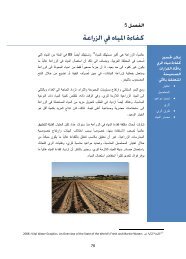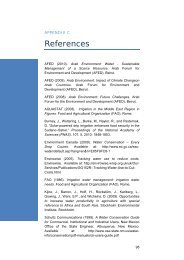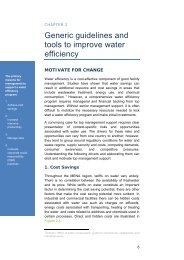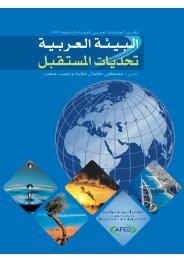Impact of Climate Change on Arab Countries - (IPCC) - Working ...
Impact of Climate Change on Arab Countries - (IPCC) - Working ...
Impact of Climate Change on Arab Countries - (IPCC) - Working ...
Create successful ePaper yourself
Turn your PDF publications into a flip-book with our unique Google optimized e-Paper software.
ARAB ENVIRONMENT: CLIMATE CHANGE 133<br />
Objective<br />
The ultimate objective <str<strong>on</strong>g>of</str<strong>on</strong>g> the C<strong>on</strong>venti<strong>on</strong><br />
(Article 2) is the ‘stabilizati<strong>on</strong> <str<strong>on</strong>g>of</str<strong>on</strong>g> greenhouse gas<br />
c<strong>on</strong>centrati<strong>on</strong>s in the atmosphere at a level that<br />
would prevent dangerous anthropogenic interference<br />
with the climate system.’ The C<strong>on</strong>venti<strong>on</strong><br />
did not define or quantify what is meant by dangerous,<br />
nor did it specify a time period for acti<strong>on</strong>,<br />
except to say that the level should be achieved<br />
within a time frame sufficient:<br />
1. to allow ecosystems to adapt naturally to climate<br />
change;<br />
2. to ensure that food producti<strong>on</strong> is not threatened;<br />
and<br />
3. to enable ec<strong>on</strong>omic development to proceed<br />
in a sustainable manner.<br />
Principles<br />
Several principles were negotiated and enshrined<br />
in Article 3 <str<strong>on</strong>g>of</str<strong>on</strong>g> the C<strong>on</strong>venti<strong>on</strong>. We list them<br />
here in the order they appear in the C<strong>on</strong>venti<strong>on</strong>.<br />
Equity, Resp<strong>on</strong>sibility and Capability (Article<br />
3.1): <strong>Countries</strong> are to ‘protect the climate system<br />
. . . <strong>on</strong> the basis <str<strong>on</strong>g>of</str<strong>on</strong>g> equity and in accordance<br />
with their comm<strong>on</strong> but differentiated resp<strong>on</strong>sibilities<br />
and respective capabilities.’ A strict<br />
applicati<strong>on</strong> based <strong>on</strong> resp<strong>on</strong>sibility and capability<br />
would require a few countries to take most<br />
<str<strong>on</strong>g>of</str<strong>on</strong>g> the acti<strong>on</strong>. This principle led to a commitment<br />
by developed countries <strong>on</strong> providing<br />
financial resources.<br />
Cost-effectiveness (Article 3.3): ‘Policies and<br />
measures to deal with climate change should be<br />
cost-effective, so as to ensure global benefits at<br />
the lowest possible cost.’ This principle led to<br />
the so-called flexibility mechanisms under the<br />
Kyoto Protocol (see below).<br />
Comprehensiveness (Article 3.3): ‘Policies and<br />
measures should . . . be comprehensive, cover all<br />
relevant sources, sinks and reservoirs <str<strong>on</strong>g>of</str<strong>on</strong>g> greenhouse<br />
gases and adaptati<strong>on</strong>, and comprise all ec<strong>on</strong>omic<br />
sectors.’ Avoided deforestati<strong>on</strong> and<br />
afforestati<strong>on</strong> should be part <str<strong>on</strong>g>of</str<strong>on</strong>g> any soluti<strong>on</strong>.<br />
Commitments: Based <strong>on</strong> the above principles,<br />
several commitments were negotiated and agreed<br />
up<strong>on</strong>. The following merit special attenti<strong>on</strong>:<br />
Emissi<strong>on</strong> Targets (Articles 4.2(a) and 4.2(b)):<br />
Developed countries are to adopt policies and<br />
measures ‘with the aim <str<strong>on</strong>g>of</str<strong>on</strong>g> returning . . . to their<br />
1990 emissi<strong>on</strong>s levels these anthropogenic emissi<strong>on</strong>s<br />
<str<strong>on</strong>g>of</str<strong>on</strong>g> carb<strong>on</strong> dioxide and other greenhouse<br />
gases’. These articles did not specify a time frame<br />
over which this return was to be accomplished<br />
and were superseded by the Kyoto Protocol.<br />
However, for those countries that did not ratify<br />
the Protocol but have ratified the C<strong>on</strong>venti<strong>on</strong>,<br />
this commitment still stands.<br />
Technology Assistance: In Article 4.1(c), all<br />
countries agreed to ‘promote and cooperate in<br />
the development, applicati<strong>on</strong> and diffusi<strong>on</strong>,<br />
including transfer, <str<strong>on</strong>g>of</str<strong>on</strong>g> technologies, practices and<br />
processes that c<strong>on</strong>trol, reduce, or prevent anthropogenic<br />
emissi<strong>on</strong>s <str<strong>on</strong>g>of</str<strong>on</strong>g> GHGs’. This provisi<strong>on</strong> was<br />
very important to developing countries during<br />
the negotiati<strong>on</strong>s. It is reiterated in at least 8 different<br />
articles <str<strong>on</strong>g>of</str<strong>on</strong>g> the C<strong>on</strong>venti<strong>on</strong> and in three different<br />
articles <str<strong>on</strong>g>of</str<strong>on</strong>g> the Kyoto Protocol.<br />
Financial Resources: In Article 4.3, developed<br />
countries agreed to ‘provide the new and additi<strong>on</strong>al<br />
financial resources . . . needed by developing<br />
countries to meet the agreed full incremental<br />
costs <str<strong>on</strong>g>of</str<strong>on</strong>g> measures covered under Article 4.1’.<br />
Since ratificati<strong>on</strong>, however, these funding flows<br />
have been a tiny fracti<strong>on</strong> <str<strong>on</strong>g>of</str<strong>on</strong>g> the amount needed<br />
to ‘green’ the energy sectors <str<strong>on</strong>g>of</str<strong>on</strong>g> developing countries.<br />
V. THE KYOTO PROTOCOL<br />
The Kyoto Protocol took two years to negotiate<br />
(1996-97) and eight years to ratify (2005). Its<br />
purpose was to define more precisely the emissi<strong>on</strong>s<br />
reducti<strong>on</strong> commitments <str<strong>on</strong>g>of</str<strong>on</strong>g> developed<br />
countries because those in the C<strong>on</strong>venti<strong>on</strong> were<br />
thought to be ‘vague.’ It has been ratified by 171<br />
countries. The United States is the principal<br />
excepti<strong>on</strong>.<br />
Article 3.1 <str<strong>on</strong>g>of</str<strong>on</strong>g> the Kyoto Protocol required developed<br />
countries to reduce their collective emissi<strong>on</strong>s<br />
<str<strong>on</strong>g>of</str<strong>on</strong>g> greenhouse gases by at least 5% below<br />
their 1990 levels between 2008 and 2012.<br />
However, this provisi<strong>on</strong> applies <strong>on</strong>ly to 35 ratifying<br />
countries and the European Uni<strong>on</strong>, representing<br />
less than two-thirds <str<strong>on</strong>g>of</str<strong>on</strong>g> the developed<br />
country emissi<strong>on</strong>s. Thus, successful implemen-
















